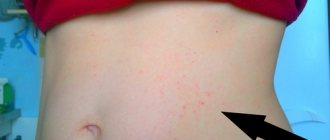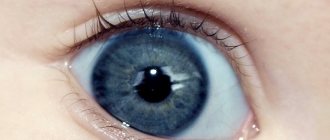Swollen gums in a baby
When a newborn is born, his parents will have to learn how to care for the little one and closely monitor his health. At first, many of them face sleepless nights and colic, and a little later the time comes for new teeth to appear.
If the baby is naughty, the mother should look into the baby’s mouth and look at his gums in anticipation of the first tooth. However, swelling of the gums can be a sign not only of the eruption of baby teeth, but also of certain diseases.
Causes
The main and most common cause of gum swelling in infants in the first year of life is the appearance of teeth. Unfortunately, many children have a hard time with the eruption of their baby teeth. They suffer from pain, increased salivation and constant itching. Some babies teething with a high fever and other unpleasant symptoms.
Note that the first signs that the baby will soon erupt a tooth may appear two or even four weeks before it “pecks.”
Most toddlers please their parents with their first teeth at 5-6 months of age , but depending on the individual characteristics of some infants, the first tooth may appear several months earlier, while others acquire their first incisors only by their first birthday.
Mom may notice swelling of the baby’s gums in the following situations:
- The baby developed caries. This disease can affect even the first teeth of a toddler if parents neglect to carefully care for the baby’s oral cavity, lick the pacifier or spoon given to the baby, or allow the child to drink sweet tea or compote at night. Bacteria accumulating on the surface of baby teeth destroy the enamel, and if you do not immediately show the baby to the dentist and do not treat the teeth, the risk of further spread of infection increases, which sometimes ends in tooth loss.
- The baby contracted stomatitis. The disease can be provoked by bacteria, viruses, fungi (they most often affect the gums of children under one year of age) and other causes. In addition to swelling of the gums, stomatitis in an infant is manifested by the appearance of plaque, rashes or spots on the oral mucosa. The baby’s general condition may deteriorate greatly and the temperature often rises.

- The baby damaged his gums with something sharp or hard. As a result of such an injury, the gum mucosa may become inflamed, which will manifest itself as an increase in size, increased bleeding and pain.
- The baby does not have enough vitamin C or other nutrients. This situation can also lead to problems with the gums, making them looser, enlarged and prone to bleeding.

Gums during teething in infants: photo, normal and possible complications
In rare cases, the eruption of baby teeth is not accompanied by obvious discomfort.
All parents are looking forward to these first and quite serious changes in the life of their beloved baby with impatience and excitement.
It is important to know what symptoms accompany this process and how to identify changes occurring in the gums.
What does the gums look like when the baby’s first teeth erupt (there are many photos of infants’ gums in the article)? What should parents do if her color turns white, blue or black?
Should I consult a doctor if there is a bruise or hematoma, swelling, inflammation or even blood before eruption?
What gums look like
Long before the first incisors appear, significant changes in muscle tissue can be observed - the main sign of changes in the child’s body.
The color of the tissue structures in the gum area changes: they become more loose.
In the area where the cobs appear, there is swelling and a slight increase in size of the mucous membrane.
The inflamed gum becomes reddish, but it is possible that it may also acquire bluish, burgundy or purple hues, which becomes a serious cause for concern on the part of parents.
As the cutter approaches the surface, the white spot becomes more distinct and noticeable. The final stage is the release of the cobs from the tissue structures.
This happens within three days, but unpleasant and disturbing symptoms can last much longer.
The very first harbinger of long-awaited changes in the oral cavity is severe itching in the gum area.
To eliminate unpleasant and uncomfortable sensations, the baby constantly tries to scratch this area with his hands and begins to put toys in his mouth.
What does the swollen upper gum look like during and before the eruption of the first teeth in children, photo:
Swollen gums when the lower teeth erupt in an infant, photo:
Problems and solutions
Swelling and redness of the gums when incisors and molars appear is considered normal and should not cause concern to parents. This process is not always accompanied only by the described symptoms.
Parents are faced with blueness of muscle tissue, the appearance of hematomas and bruises, which causes panic.
To minimize possible complications, it will be useful for caring parents to become familiar with the etiology of deviations from the norm and how to eliminate them.
Why does pulpitis of permanent teeth occur in children and how to treat it? Details are in this material.
You can learn about the symptoms of pityriasis rosea in children from this publication.
Is it possible to bathe a child with roseola? Our article will answer the question.
Swelling
If a baby under the age of one year has swelling of the muscle tissue, then we are most likely talking about teething .
The first milk teeth begin to erupt when the baby reaches six months of age. Sometimes - several months earlier, and in some cases - much later.
Swelling of the oral mucosa is normal. The etiology of the symptoms is associated with damage to the tissue structures of the muscle tissue under the influence of an erupting tooth.
Other signs also indicate that a child’s gums are swollen during teething. This is an increase in temperature, loss of appetite, general malaise, worsening mood.
Swelling of the gums is a natural process that should simply be endured, providing your baby with proper care and attention.
To alleviate the condition, traditional healers recommend using compresses with infusions based on chamomile, which has an anti-inflammatory effect.
Swollen or swollen gums when the first upper teeth erupt in infants, photo:
blue tint
When cutting through the incisors, you may encounter the appearance of cyanosis - acquiring a blue tint.
Did your baby's gums turn blue when teething? The cause of the symptoms is associated with ruptures of small blood vessels located in the gum, through the tissue structures of which the baby tooth erupts.
If the area of blueness is small, there is no serious cause for concern. If most of the muscle tissue has acquired a blue tint, consult a specialist about this.
Small incisions may be necessary as large amounts of fluid and blood will most likely have accumulated there.
Blue gums during teething of the upper teeth in children, photo:
White or black color
It will cause concern to caring parents if the gums acquire a black tint. Let's try to figure out why this happens.
These symptoms are explained by the formation of a small hematoma in the hood, which in most cases goes away on its own after the tooth appears on the surface.
Black spots can also be signs of oral diseases that develop as a result of improper care. Such symptoms can be observed with the development of gingivitis and stomatitis.
What to do if the connection between the appearance of a black tint and the appearance of the first teeth is indicated by other symptoms? It is recommended to show the baby to a pediatrician in order to exclude serious pathologies.
The gums turning white can also be a sign of sprouting. The formation of white plaque is possible before the appearance of a baby tooth on the surface of the muscle tissue, which becomes thinner as it moves.
White spots and a white stripe on the gums during teething are normal. The condition only requires regular monitoring.
The appearance of white spots can also signal the development of diseases and pathological conditions in the oral cavity.
This symptomatology is typical for:
- violations of hygiene standards. It has been noted that white spots remain on the gums after drinking milk if regular oral hygiene is not followed;
- calcium deficiency. Too young mothers and women with bad habits face this problem.
- stomatitis is a disease that affects the oral mucosa. A pathological condition develops if the child’s body needs iron, folic acid, and vitamins.
During breastfeeding, the baby's body receives insufficient nutrients;
Only a doctor can determine the etiology of the appearance of a white tint on muscle tissue, and you should contact him if these symptoms are detected.
It is necessary to exclude the development of serious pathologies that are accompanied by a white coating.
Bleeding and hematomas
Can gums bleed when teething? Gums rarely bleed during teething ; bloody discharge appears as a result of rupture of capillaries.
Such complications can be encountered when teething is difficult and is accompanied by severe swelling of muscle tissue. The flow of blood stops after a few seconds.
If the bleeding is minor and short-lived, there is no reason to worry. If such symptoms are observed on a regular basis, it is recommended to show the child to a specialist.
Most often, hematomas that can form on the surface of inflamed gums do not require surgical intervention.
A bluish tint is also characteristic of these formations - this is a signal of the accumulation of blood inside the tissue structures.
Hematomas disappear immediately after the incisor erupts. If there is a gradual increase in the formation and it reaches a large size, you should seek surgical help and make small incisions on the gum.
Swelling and inflamed gums, blood during teething in infants, photo:
Recommendations for parents
Teething causes discomfort not only for the baby, but also for parents who want to ease the child’s well-being.
To reduce bothersome symptoms, you can use:
- drugs that have analgesic and anti-inflammatory effects;
- teethers>, accelerating the appearance of the baby tooth on the surface. These are toys that contain gel or water inside.
- antipyretics for gums, which are given when the temperature rises during teething.
- traditional medicine (use mint, chamomile, lemon balm, lavender, sage).
The child will chew on the teethers and eliminate itching and soreness in the gum area;
Immediately before taking any medications, consult your pediatrician to rule out intolerance to the components of the substance;
Medicinal plants have an anti-inflammatory effect, and decoctions based on them can be used to treat gums with signs of inflammation.
Complications in which you should not hesitate to visit a doctor include the formation of large hematomas, an increase in temperature above 38 degrees, the formation of ulcers, frequent bouts of vomiting or bowel disorders, severe cough or the appearance of a runny nose, accompanied by discharge of greenish mucus.
Is a diet necessary for giardiasis for children and what should it be like? Our publication will tell you about this.
What does prickly heat look like in children in the photo, what treatment is required? You will find answers to your questions in this material.
Read about the causes of urticaria in children in this article.
What to do
The actions of parents who discover swelling of the gums in their infant will depend on the cause of such changes in the oral cavity. If the baby behaves restlessly, suffers from pain, fever and other unfavorable symptoms, the child should be shown to a pediatric dentist. The doctor will examine the baby’s mouth and determine whether the swelling is due to teething or is a disease that needs to be treated.
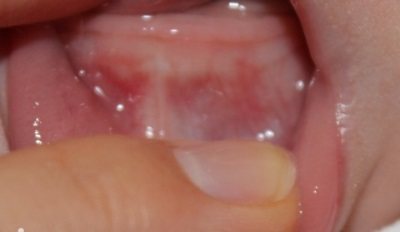
During teething
To relieve soreness and itching in the gums of a toddler, parents should purchase special toys for the baby, called teethers. also massage the gums with a clean finger, and if the baby is in severe pain, special preparations with a cooling and anesthetic effect are used, which are produced in the form of a gel.
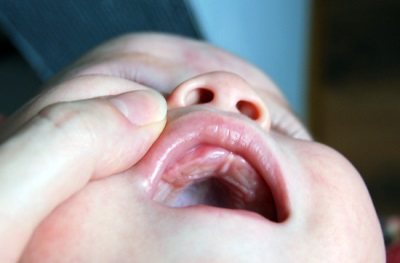
For caries
If a dentist identifies this disease in an infant, it is important to treat it immediately to prevent further destruction of dental tissue. The treatment method will depend on the stage and severity of the infection. Many children have their teeth silvered or treated with fluoride preparations, and sometimes they have to resort to removing infected tissue and filling them.
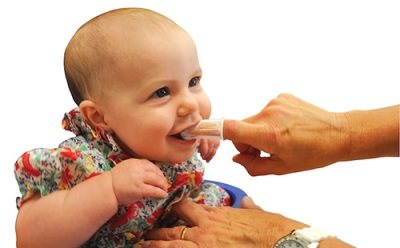
For stomatitis
In the treatment of such a disease, they first try to determine its cause, since for herpes stomatitis, antiviral drugs are prescribed, bacterial stomatitis is affected by antimicrobial agents, and for candidal stomatitis, drugs that affect fungi are indicated. Also, a child diagnosed with stomatitis should treat the oral cavity with antiseptic solutions and anti-inflammatory gels.

You will learn a lot of interesting things about the appearance of the first teeth in children from Dr. Komarovsky’s program.
Why might a baby have swollen gums and what to do in this case?
Parents often notice swollen gums in their infants. The reasons for this may be different, so we will show a photo and describe the treatment of all options. And in order not to make a mistake and prevent the development of complications in the child’s oral cavity, it is better to immediately show him to the pediatrician.
Growing up as a child does not always bring pleasure and joy of discovery. Quite often this process is accompanied by diseases, teething, colic, whims and lack of normal night sleep. In which case you should not worry, and when the signs indicate problems with the body, only a doctor can decide.
Inflammation in a child's mouth
Dental problems are not the only reason that can cause complex symptoms and swelling in the mouth. When the oral mucosa of a baby suffers, the child cannot eat normally and quickly weakens. Kids become lethargic and capricious. Caring parents should not delay in determining the cause of inflammation.
A tumor on the gum without a specific diagnosis can grow and cause the child not only discomfort, but also noticeable pain.
What to do if a child has a lump on his gum? The problem of the mucous membrane can be random or indicate systematic malfunctions in the functioning of the baby’s internal organs. When teeth are cut, the baby can damage the mucous membrane, and infection easily penetrates through the wound. Inflammation of the mucous membrane is not always dangerous, but every caring parent should make sure that the child’s health is not in danger.
The most common reasons why a child’s gums are swollen:
- milk teeth erupt;
- caries develops;
- gingivitis occurred;
- gums are injured;
- consequences arise after tooth extraction;
- permanent teeth erupt;
- advanced vitamin deficiency.
In determining the cause of a small patient’s illness, it is important what the source of inflammation looks like. The condition of the gums will help you understand what danger the baby faces and whether the baby teeth will suffer from the inaction of the parents. If emergency measures to reduce inflammation do not help, then you should immediately seek help from a specialist.
In cases where the gums are swollen, every day of delay can cost the baby’s health. Falling out milk teeth form the entire skeletal system of the upper and lower jaw, so any injuries and inflammatory processes are fraught with curvature of the bite or damage to the roots of permanent teeth. Parents must help their own child grow up to be a healthy person.
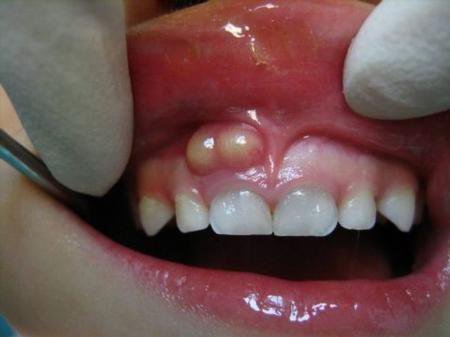
A fistula due to sinusitis formed with healthy teeth
Causes
To detect pathology or even minor irregularities, you need to know what a child’s gums look like in normal condition. To do this, look into his mouth, and you will find that the mucous membrane has a predominantly pale pinkish tint, and the gums do not in any way resemble an inflammatory process.
But with whims and changes in behavior, especially if the temperature rises, you can notice painful signs:
- the color of the mucous membrane becomes red;
- sometimes cyanosis is added to this, as a result of bursting small capillaries;
- the gums themselves swell and become inflamed;
- sometimes bubbles, spots, plaque and other formations appear on the surface of the soft tissues.
- Teething occurs most often before one year of age and explains most of the child’s reactions. At this time, the baby is capricious, pulls all objects into his mouth, and has increased salivation. A runny nose may appear and the body temperature may even rise. In the mouth you can see that the gums are swollen, sometimes a blue tint is added to this, since the process of eruption causes small vessels to burst. You can feel the hard lump with your finger. The first baby teeth are usually expected at the age of 6-8 months, but depending on individual characteristics, this period can be reduced to 3-4 months or extended to a year.
- Caries occurs even in the youngest children. Why do teeth hurt immediately after teething? This may be due to dirty nipples or spoons that the parents licked before. An abundance of sweet drinks and foods. A common cause is the habit of falling asleep with a bottle of milk. Then the bacteria multiply very quickly on the surface of the teeth, which are not yet sufficiently protected and strengthened to resist pathogenic destruction of the enamel. It is important to show your child to the dentist in a timely manner so that he can prescribe competent and adequate treatment.
- Stomatitis is an infectious disease transmitted by contact with an infected person. It is caused by viruses, bacteria and fungi. In each case, other methods of therapy and influence are needed. But pathology is always manifested by swelling of the gums, elevated temperature, various rashes and formations on the surface of the mucous membrane.
- Mechanical damage - if a child pulls various objects into his mouth and any of them turns out to be too sharp or hard, then a wound forms on the gum. The site of injury may become red, slightly inflamed, and blood may be released when the soft tissue ruptures.
- Lack of vitamins and microelements - most often, this is how the gums react to a lack of vitamin C in the body. With an unbalanced diet and low levels of important substances in the diet, a number of diseases develop, among which gum problems are popular. In this case, they become loose, bleed, increase in size, and swell.

What to do?
Even if you are sure that the inflammation and redness of the soft tissues of the baby’s mouth is associated with teething, it is still worth showing him to the pediatrician. It is especially important to seek specialist advice if the process is accompanied by other symptoms. And if a rash and high temperature appear, this should be done immediately.
Let us describe what doctors’ recommendations exist depending on the reasons that affected the condition of the child’s mucosa:
- If pain and whims are associated with teething, then there is no need to worry. But try to make this process easier for your baby. Buy him some teethers. They have a special gel inside that freezes when cooled in the refrigerator, and when the child bites it, the cold produces a pain-relieving effect. Also today, many different gels and ointments with an anesthetic effect have been created. Doctors often prescribe homeopathic tablets.
- When baby teeth become infected with caries, it is important to detect the problem in a timely manner and begin to eliminate it in the early stages. After all, the pathological process in the children's oral cavity develops very rapidly. And due to the weakness of the enamel, all teeth can be destroyed. Depending on the intensity and stage of the disease, the dentist uses silver plating, fluoridation or filling. In extreme situations, it is necessary to remove the affected tissue.
- In the case of stomatitis, complex therapy is prescribed. The main remedy is selected depending on the cause of the pathology. So, if it is a bacterial infection, then antibiotics are prescribed, and for fungi and viruses, appropriate medications are prescribed. To alleviate the condition, apply applications or rinse the oral cavity with various antiseptic and soothing solutions, lubricate with anesthetic gels.
Video: a child's first teeth.
It is important not to self-medicate, but to consult a pediatrician. After all, with an incorrect diagnosis and erroneous actions, you can harm a fragile body.
Signs of teething in a four month old baby
Signs of teething in infants are easy to recognize. The child is restless, capricious, there is increased salivation, and a high temperature rises. The gums itch, swell, and redness appears.
Salivation
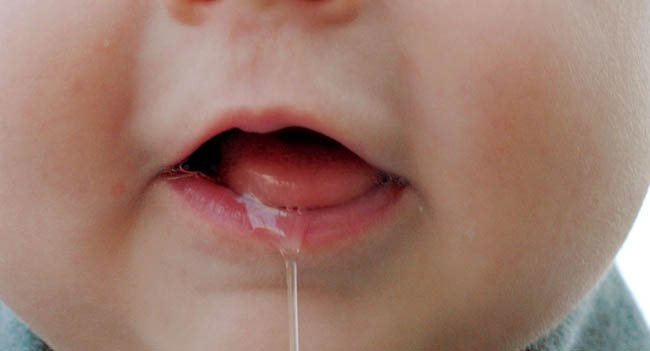
When teething, a 4-month-old baby begins to salivate profusely. It's easy to spot. During this period, it is recommended to use baby bibs. If there are no bibs, then change clothes that are wet from saliva. As soon as the crown of the tooth appears, salivation decreases or disappears.
Fever, cough and runny nose
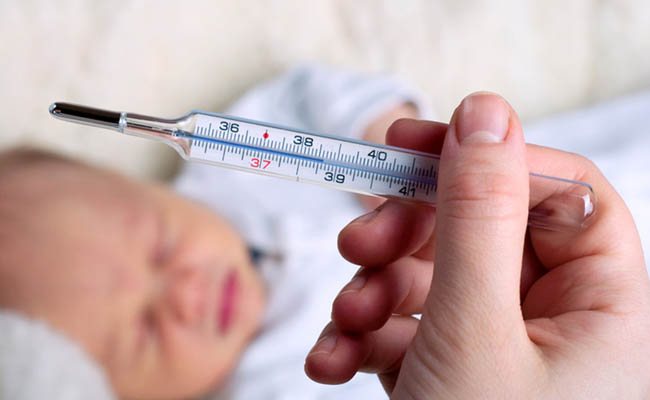
During this period, infants' immunity decreases. The body is susceptible to infection. There is a cough from excessive salivation and a runny nose. The temperature rises to 37.0–37.5. If the temperature stays below 38 degrees, then it cannot be brought down. If it rises higher, there is a high probability of infection.
Sensitivity and itching of gums
The baby scratches his gums with any available objects, as well as with his own hands. To avoid getting hands that are unsuitable for this item, it is recommended to purchase special teethers for carding.
Anxiety, crying, poor sleep
Swollen gums begin to itch and hurt. The child becomes restless and cries often. He wakes up at night not to eat, but simply to scratch the swollen places.

Eating disorder
When the gums itch, the baby refuses to eat. At an early age, the baby refuses the breast or bottle with formula. It is difficult for him to suck on a bottle and breast because his gums itch.
Constipation and diarrhea
The period of teething manifests itself in the form of profuse diarrhea, more than 8 times a day. And also constipation. If you do not empty your bowels within 3 days, you must take auxiliary measures. This could not be done before.
Teething
Let's look at an approximate teething schedule. Usually the first tooth comes out at the age of 5-7 months . Parents can track the process of teething, and sometimes it becomes an unexpected discovery. First of all, parents notice that the child’s gums are swollen. In children under one year old, it can swell only in one case - there will be a tooth soon.
Swollen gums hurt, the baby cries or whines all the time. He's in pain. After all, any adult remembers how his wisdom teeth erupted. This is very unpleasant. And the child has to endure this pain almost all the time. The worst thing is that this process can take a very long time.
Basically, the first teeth are the lower incisors. Then the top two enter. And there comes a short lull. Next, climb the side and bottom and top. Sometimes at the same time. Then another break. Next are the chewing teeth, the so-called molars. Next come the canines and behind them the remaining molars. There should be 20 pieces in total. All teeth should be present by age two.
This problem worries all parents. How does swollen gum manifest itself? She manifests herself in very different ways. But the main symptoms are: slightly painful redness of the cheeks, lethargy, low temperature, crying, loose stools, runny nose and even cough. All this happens because the gums hurt. The tooth must make its way through. And this causes the gums not only to hurt, but also to itch unbearably. All this creates severe discomfort for the child’s well-being.
Other causes of gum irritation
A 3-month-old child’s gums itch not only when teeth appear. This can be caused by allergic reactions, dental diseases, and neuroses. In such cases, it is recommended to call a doctor and undergo treatment.
Allergy
If a child constantly scratches something in his mouth, this is in some cases caused by an allergic reaction. Scratching occurs when there is an allergy to formula milk, and often occurs when complementary foods are introduced at 4-6 months. The itching goes away immediately after contact with the allergen is removed.
Dental diseases
- Gingivitis often appears in childhood. Accompanied by an unpleasant odor from the mouth, the gums become red, swollen, and itchy.
- Periodontitis – rarely seen in infants, is characterized by itchy gums, bad breath and tooth sensitivity.
Neuroses
In childhood neuroses, the symptoms coincide with teething. The child wakes up at night and refuses to eat and is restless. This reaction of the body is caused by a very vivid, memorable event in a child’s life.
Causes of gum swelling in infants
- Teething is the main and most common cause of this phenomenon.
- Stomatitis - the gums become swollen and red, and small ulcers appear in the mouth. A pungent odor appears from the mouth. If all the symptoms are present, then you need to run to the doctor.
- Caries. This also happens to babies. For example, if several teeth already exist, and parents neglect hygiene procedures for the child, then such a problem may well arise. It must be remembered that sweet waters, juices and sweets contribute to the formation of caries.
- Lack of vitamin C and deterioration of immunity. In this case, wounds may appear in the baby’s mouth that do not heal well and the gums bleed.
- Mechanical gum injuries.
How to relieve your baby's condition
When the gums itch and teeth are cutting in a 3-month-old baby, you need to alleviate the condition as much as possible. To do this, use drugs that are freely sold in pharmacies. They use medications designed specifically for children. They contain a lower concentration of the active substance, which will not harm your health and will help get rid of itching.
- Temperature increase. They use Paracetamol and Ibuprofen in the form of a suspension and suppositories. Take in accordance with the instructions, always taking into account the age of the child.
Panadol Baby
- Runny nose. For a runny nose, nasal drops based on sea water are prescribed. Place 2 drops in each nostril. After 5 minutes, the nose must be cleared of mucus using a baby aspirator.
- Pain in the gums. Use ointments and gels based on chamomile and calendula. These gels are used to lubricate the gums 3-4 times a day. They have a cooling effect and temporarily relieve pain.
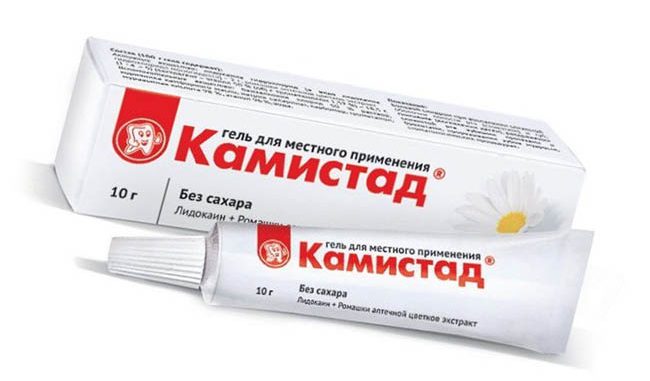
Kamistad
How to help a child and relieve him of unpleasant sensations?
The main task of parents is to help the baby cope with unpleasant sensations. It is necessary to devote more time to the child, to take him in your arms if the baby feels better with close contact. Excessive salivation and increased body temperature lead to a lack of fluid, so the child should be provided with frequent and plentiful drinks.
Medicinal methods for pain relief:
- Local gels with an anesthetic effect. It is necessary to lubricate the baby’s swollen gums with the drug 3-4 times a day. Gels have a short-term effect (no longer than 2 hours), but quickly relieve pain.
- Painkillers and antipyretics. In case of high body temperature and severe anxiety, it is allowed to take ibuprofen (Nurofen) or paracetamol (Efferalgan) based products. You should carefully study the instructions for use and do not exceed the permissible dosage, because Some components of the products cause adverse reactions.
- Anti-inflammatory decoctions. You can prepare decoctions of chamomile, oak bark or sage at home. It is necessary to pour boiling water over the herbs, leave for several hours, cool and strain. When teething, the inflamed gum is lubricated with the prepared decoction. Such drugs have anti-inflammatory and disinfectant properties.
- Teethers (see photo for what they look like). Special devices can reduce discomfort and itching. They speed up the process of tooth growth and distract the baby. There is a large selection of teethers made from different materials and at different prices. As a rule, they are filled with gel or water. It is recommended to disinfect and cool devices before use.
Treatment with folk remedies
You need to know what to do if your child’s gums itch, and what folk remedies to use. They help temporarily soothe the itching.
Teething is an essential part of every baby's development. You just need to survive this period and help cope with it. At what time the gums begin to itch depends on the individual characteristics of the child.
How to understand that these symptoms are due to teeth?
The fact is that when the gums swell, they provoke inflammation . The body produces antibodies and this can even cause a fever. That is, there is resistance to the disease. But, in any case, you should always call a doctor to make sure that it is not a virus or a problem of another origin. After all, when teething, the child’s immunity decreases, this is a well-known fact.
This is a difficult and nervous period for the whole family. For many children and parents, teething comes with problems. But there are also those who don’t even notice their appearance. Even if there is no fever or other symptoms similar to the disease, it is usually immediately clear that the gums are swollen. The child becomes capricious, nervous, loses appetite, becomes whiny and rubs his face all the time. The most obvious sign is, of course, excessive salivation. There is no doubt left here.
To alleviate pain and itching, you can give your baby special teethers to chew on. It's better when they're cold. To do this, you can simply put one in the refrigerator for an hour.
The baby puts everything in his mouth. He needs to be distracted from the pain all the time. You can buy special gels to relieve pain; they have a cooling and kind of freezing effect. It also helps a lot to massage your gums. This can be done with a clean finger wrapped in a clean napkin or cloth. Like rubbing a sore spot.
Many begin to painfully bite their mother during feeding. You just need to say several times that you can’t do this. Over time, the child will understand. But in this way he simply calms himself down. During teething, when the gums swell, the child needs increased attention and love from his parents. We need to feel more sorry for him and calm him down. One should not think that this will spoil and spoil his character, because a bad mood and endless tears bring much more harm.
Often, due to swollen gums, another symptom is added in the form of diarrhea and fever. This may be due to a decrease in the body's natural defenses. A temperature of up to 39 degrees for two days can be considered normal in this situation . But before giving antipyretics, you should consult your doctor.
Diarrhea may also be due to the fact that the body secretes a lot of saliva and the child swallows it more than usual, which speeds up the processes in the intestines. But in this case, this phenomenon will occur no more than 2-3 times a day for up to three days. If more, then you need to see a doctor.
A runny nose and even a cough often occur. This happens because there is too much saliva and mucus in the mouth. But all this should be no more than 2-3 days due to teeth. Otherwise, it’s already a cold. Sometimes the gums swell at a very early age, when it seems that it is too early for teeth to erupt. But that's just how it seems.
Firstly, swollen gums do not mean that the tooth will definitely come soon. It can swell even a couple of months before the tooth itself erupts. This could be preparation, walking paths. It often happens that all the symptoms are on the face, saliva flows like a river, the gums are huge, but there is no tooth. And this can continue for several months.
Secondly, there is no strict time frame for teething. This can happen at 6 months. Or maybe at 1 year. And in rare cases it happens at 2 months. There are also unique facts when a child is born with several teeth. All these are variants of the norm. The child does not have to meet the standards, everything is individual.
Causes
To detect pathology or even minor irregularities, you need to know what a child’s gums look like in normal condition. To do this, look into his mouth, and you will find that the mucous membrane has a predominantly pale pinkish tint, and the gums do not in any way resemble an inflammatory process.
But with whims and changes in behavior, especially if the temperature rises, you can notice painful signs:
- the color of the mucous membrane becomes red;
- sometimes cyanosis is added to this, as a result of bursting small capillaries;
- the gums themselves swell and become inflamed;
- sometimes bubbles, spots, plaque and other formations appear on the surface of the soft tissues.
- Teething occurs most often before one year of age and explains most of the child’s reactions. At this time, the baby is capricious, pulls all objects into his mouth, and has increased salivation. A runny nose may appear and the body temperature may even rise. In the mouth you can see that the gums are swollen, sometimes a blue tint is added to this, since the process of eruption causes small vessels to burst. You can feel the hard lump with your finger. The first baby teeth are usually expected at the age of 6-8 months, but depending on individual characteristics, this period can be reduced to 3-4 months or extended to a year.
- Caries occurs even in the youngest children. Why do teeth hurt immediately after teething? This may be due to dirty nipples or spoons that the parents licked before. An abundance of sweet drinks and foods. A common cause is the habit of falling asleep with a bottle of milk. Then the bacteria multiply very quickly on the surface of the teeth, which are not yet sufficiently protected and strengthened to resist pathogenic destruction of the enamel. It is important to show your child to the dentist in a timely manner so that he can prescribe competent and adequate treatment.
- Stomatitis is an infectious disease transmitted by contact with an infected person. It is caused by viruses, bacteria and fungi. In each case, other methods of therapy and influence are needed. But pathology is always manifested by swelling of the gums, elevated temperature, various rashes and formations on the surface of the mucous membrane.
- Mechanical damage - if a child pulls various objects into his mouth and any of them turns out to be too sharp or hard, then a wound forms on the gum. The site of injury may become red, slightly inflamed, and blood may be released when the soft tissue ruptures.
- Lack of vitamins and microelements - most often, this is how the gums react to a lack of vitamin C in the body. With an unbalanced diet and low levels of important substances in the diet, a number of diseases develop, among which gum problems are popular. In this case, they become loose, bleed, increase in size, and swell.
What do gums look like when they erupt, and why do they swell?
In the photo you can clearly see the condition and general appearance of the gums during teething. They differ from healthy and normal mucous membranes, which have a pale pink tint.
What gums look like in children:
- the mucous membrane becomes red and swollen;
- When the gums erupt, they change their structure (become loose);
- as the crown is pushed out, a white spot appears on the surface of the gum;
- When a sharp crown comes out on the surface of the gum, a small wound or abrasion occurs.
The signs listed above can be seen in the photo; they are a variant of the norm and are found in all infants. Sometimes a characteristic white or yellow coating appears (a large amount of saliva contains many bacteria), small hemorrhages in the form of red dots (if blood vessels are affected).
Swelling of the gums is a natural and easily explained process. Initially, tooth germs are located deep in the alveolar processes. Gradually they grow, enlarge and begin to be pushed out, which is called eruption. The crown first breaks through dense bone tissue. This difficult stage is not accompanied by pronounced symptoms or visual manifestations.
What to do?
Even if you are sure that the inflammation and redness of the soft tissues of the baby’s mouth is associated with teething, it is still worth showing him to the pediatrician. It is especially important to seek specialist advice if the process is accompanied by other symptoms. And if a rash and high temperature appear, this should be done immediately.
Let us describe what doctors’ recommendations exist depending on the reasons that affected the condition of the child’s mucosa:
- If pain and whims are associated with teething, then there is no need to worry. But try to make this process easier for your baby. Buy him some teethers. They have a special gel inside that freezes when cooled in the refrigerator, and when the child bites it, the cold produces a pain-relieving effect. Also today, many different gels and ointments with an anesthetic effect have been created. Doctors often prescribe homeopathic tablets.
- When baby teeth become infected with caries, it is important to detect the problem in a timely manner and begin to eliminate it in the early stages. After all, the pathological process in the children's oral cavity develops very rapidly. And due to the weakness of the enamel, all teeth can be destroyed. Depending on the intensity and stage of the disease, the dentist uses silver plating, fluoridation or filling. In extreme situations, it is necessary to remove the affected tissue.
- In the case of stomatitis, complex therapy is prescribed. The main remedy is selected depending on the cause of the pathology. So, if it is a bacterial infection, then antibiotics are prescribed, and for fungi and viruses, appropriate medications are prescribed. To alleviate the condition, apply applications or rinse the oral cavity with various antiseptic and soothing solutions, lubricate with anesthetic gels.
Video: a child's first teeth.
It is important not to self-medicate, but to consult a pediatrician. After all, with an incorrect diagnosis and erroneous actions, you can harm a fragile body.

